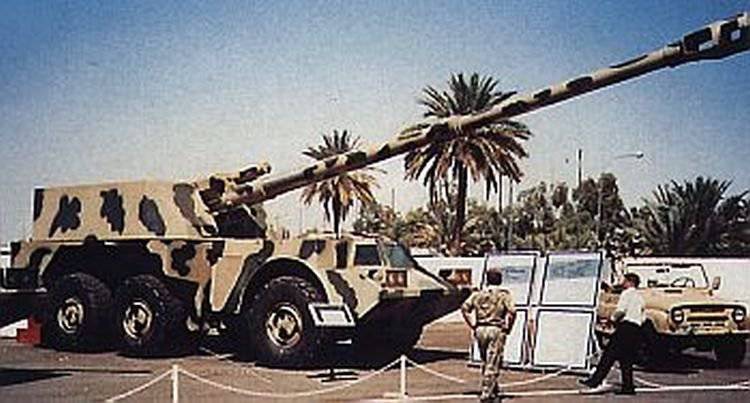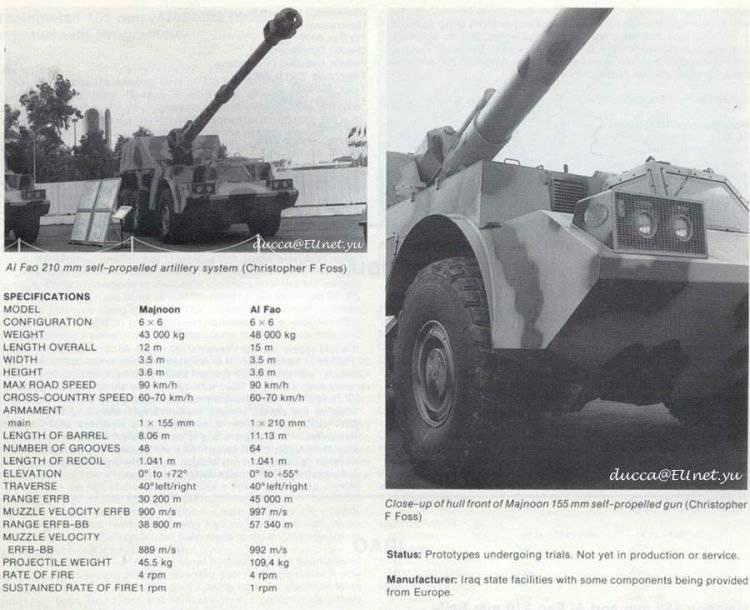Armament of the armed forces of Iraq - self-propelled howitzers 155mm "Majnoon" and 210mm "Al Fao"
The beginning of the development of technology - 1987 year. Spanish and French designers take part in the work on self-propelled artillery systems. In Spain (the Tribiland company) they worked on the undercarriage of the ACS, in France they were working on the guns of the future ACS. Both combat vehicles were created on the basis of the South African machine “Rhino”, on which the South African self-propelled artillery gun G6 was built.

At that time, it was the third attempt in the world (excluding the USSR) to create such artillery systems on a wheelbase. The formula of the wheels of the new SAU 6X6. Before the Iraqis, self-propelled self-propelled howitzer 152mm Dana and South Africa (self-propelled howitzer 155mm G-6) were created in Czechoslovakia. The creation of the 210mm self-propelled gun at that time was dictated by ensuring superiority over the “neighbor” (Iran), which was armed with the American self-propelled 175mm howitzer “M107”.
The first public appearance of the new ACS is the spring of 1989. Two prototypes were transported from Spain to Iraq on the An-124 transport aircraft, to the second international exhibition of military equipment, held in the capital of Iraq - Baghdad. Accurate data on the adoption of the two SAU data in the ground forces of Iraq is not, according to some data, only these two samples were accepted. Data on serial production is not. In subsequent military conflicts, self-propelled howitzers did not participate.
Before we continue the story, we note that the creation of new self-propelled guns for the Iraqi SV was not without the participation of a talented Canadian design engineer Gerald Bull, who was engaged in the creation of long-range guns. Under his personal leadership, the Babylon project was launched in Iraq - the creation of a supergun with a caliber 350mm with a barrel length of 160 meters. The estimated firing range of up to one thousand kilometers of conventional shells and up to two thousand - rocket ammunition. Such weapon could hold the entire region at gunpoint, so it is not surprising that the assassination of a Canadian engineer in 1990 was attributed to Israeli security forces. Based on the opinions of specialists who examined the remnants of super-weapons, after the end of the military conflict in the Persian Gulf, D. Bull had every chance to finish building his gun, but after his death all the work on gun completion was stopped, perhaps Iraq did not have enough time and money - in 1991, the Persian Gulf War began.

Design and construction of Iraqi self-propelled howitzers
Both howitzers have the same chassis. Department of management performed in the front of the case in which the driver-mechanic. The driver-mechanic's seat is made according to the type of ACS G6, the review is carried out through three armored windows, the driver-mechanic is seated through a hatch in the upper part of the cab. Next is MTO, in which a diesel engine was installed from the German company Mercedes-Benz, with the power characteristics of the HP 560. OU is completely isolated from MTO. In the back of the case installed tower part. On each side there are access hatches for landing the crew of the car. In the back of the tower there is a special boot for loading ammunition into the car. At the bottom there are two hatches for emergency exit from the tower of the machine. The chassis is provided with wheels with 21.00 XR25 tires and an automatic pressure support system. For the firing of a howitzer, in additional supports, according to the calculations of designers, there is no need.
The main differences between the samples - the artillery part of the machines. The Majnoon self-propelled howitzer is equipped with an 155mm barrel of caliber 52 length, having an ejector device and a transversely slit muzzle brake, and an Al Fao self-propelled howitzer gun has a 210mm barrel with an ejector gun and X-ch-ch-ch-ch-ch-ch-ch-ch-ch-ch-ch-ch-chi. . In both machines, the sighting device for direct fire is located on the left side of the tower, next to the gun.
Both howitzers were designed for firing long-range projectiles such as ERFB and ERFB-BB with gas generators, which are the main ammunition for the towels of G-5 and GH N-45 towed type. Active-missiles were not used.
The main characteristics of the self-propelled howitzer "Majnoon":
- weight - 43 tons;
- length - 12 meters;
- width - 3.5 meters;
- height - 3.6 meters;
- highway speed / not equipped roads - 90 / 70 km / h;
- caliber - 155mm;
- barrel length - 806 centimeters or 52 caliber;
- The number of rifling barrels - 48;
- ACS rollback - 1041 centimeter;
- vertical / horizontal pointing angles - (0-72) / ± 40 degrees;
- firing range ERFB / ERFB-BB - 30.2 / 38.8 kilometers;
- the initial velocity of the projectile - 900 meters;
- the weight of the projectile increased range - 45 kilogram;
- gun firing rate - up to 4 high / min.
The main characteristics of the self-propelled howitzer gun "Al Fao":
- weight - 48 tons;
- length - 15 meters;
- width - 3.5 meters;
- height - 3.6 meters;
- highway speed / not equipped roads - 90 / 70 km / h;
- caliber - 210mm;
- barrel length - 1113 centimeters or 53 caliber;
- The number of rifling barrels - 64;
- ACS rollback - 1041 centimeter;
- vertical / horizontal pointing angles - (0-55) / ± 40 degrees;
- firing range ERFB / ERFB-BB - 45 / 57.3 kilometer;
- the initial velocity of the projectile - 990 meters;
- the weight of the projectile increased range - 109.5 kilogram;
- gun firing rate - up to 4 high / min.
Information sources:
http://prom1.livejournal.com/203824.html
http://raigap.livejournal.com/165615.html
http://ru.wikipedia.org/wiki/G6
http://www.artillerist.ru/modules/myarticles/print_storyid_69.html
Information